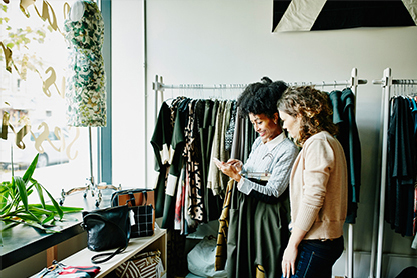
Content Based Selling Series
Part 3 of 3
To read part one please click here to read part two please click here.
82% of smartphone users turn to their phone to influence a purchase decision while in-store.1
In this series, we talked about the in-store experience and the role associates play in providing it. However, there is another major space where consumers go to fulfill their retail needs that we did not yet discuss: online.
While online shopping continues to grow rapidly, a majority of consumers in the US still go to brick and mortar stores for their retail experience. Additionally, many are utilizing both the online and offline retail experience - otherwise known as Omnichannel shopping.
Omnichannel shopping allows for consumers to buy anywhere and for retailers to fulfill purchases in multiple ways, and although this is the original definition of the buzzword, it has been subject to change recently. This is due to the fact that retailers vary in their adoption of Omnichannel:
1. Some retailers are running behind, ofering little to no experinces for their consumers
2. Others are focusing on a few channels (online and in-store), only beginning to see the benefits omnichannel provides them
3. More are focusing on a unified infrastructure to bring omnichannel to life through integrated solutions
With all of these different efforts, it’s easy to see how the definition of Omnichannel has been thrown around. The bottom line is consumers want to be able to buy from anywhere and retailers want to be able to fulfill from anywhere.
“Mobile enabled store associates can transform the retail experience today with Omnichannel capabilities.”
In order for a retailer to provide a true omnichannel experience, they need to integrate a series of digital and physical touch-points:

Additionally, in order for retailers to be considered truly Omnichannel, all of these experiences and offers must be able to be replicated anytime and anywhere as retail brands integrate themselves into the everyday life of their customers’ lifestyles. With all of this data, retailers are able to provide personalized offers and relevant engagements.
“If you can’t sell it where and when the consumer wants to buy, you missed a purchase. Make sure consumers aren’t going somewhere else for a better experience- be convenient to consumers.”
It is important to remember that offering convenience is a valuable aspect that many consumers look at when making a purchasing decision. Consumers have their own timeline and process to go through and in order for them to stay loyal, retailers need to provide ways for consumers to shop how they want to, creating a stronger brand loyalty.
It is due to these reasons and more that Samsung SDS built the retail platform, Nexhop for Samsung Experience Stores. This platform provides an enjoyable customer experience, focused on the key lever that brick & mortar retailers have over their e-commerce counterparts-empowering sales associates. By empowering sales associates, retailers are able to deliver accurate, up-to-date, and detailed product information in a warm and engaging manner-while also integrating all the necessary channels that consumers have access to.
Do you know how you will implement your omnichannel experience?
*Photo Credit: Absolutdata

Andy Umans is the Senior Manager for Samsung SDSA’s Global Business Development Team and has been with Samsung Group for 4.5 years now. He is the head of Retail Innovation and is responsible for setting the overall strategy and operations for the Solutions Business Unit of SDSA. Andy has spent over a year working with major retailers and technology partners to define Samsung’s vision for smart Retail.
- 3 steps to optimizing the car dealership showroom experience
- How to enhance modern dealership operations: Inventory, staffing, and showroom management
- Reducing costs with affordable and resourceful mPOS
- Improving the user experience with mPOS
- Mobile point-of-sale systems: How they streamline the user experience & maximize ROI
- Making inroads into QSR digital transformation
